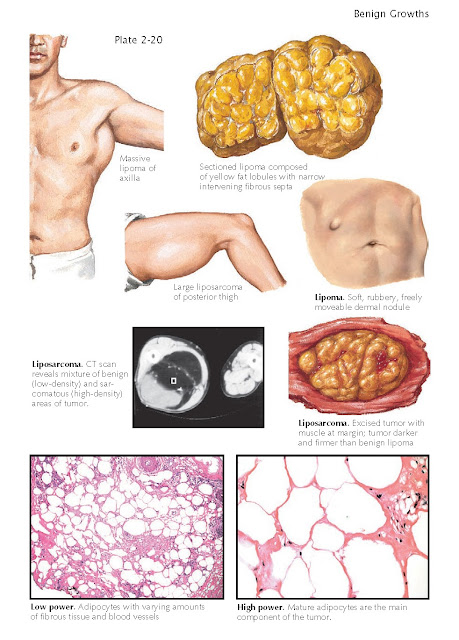LIPOMA
Lipomas are common
benign skin growths that can be seen as solitary lesions and frequently as
multiple dermal nodules scattered about the skin. The lipoma is an overgrowth
of the fibrofatty adipose tissue in the subcutaneous tissue plane. Patients
with multiple lipomas often describe a familial inheritance pattern.
Clinical Findings: Lipomas are often small (1-2 cm), soft,
subcutaneous nodules that are slow growing and freely moveable underneath the
skin. Some lipomas become quite large (>5 cm in diameter), and they can be a
cause for concern due to interference with movement and the possibility of
malignant degeneration into a liposarcoma. There are no overlying epidermal
changes, and there is no connection to the epidermis. Most often they are
asymptomatic, but they can become painful if traumatized.
In stark contrast, a rare variant
called the angiolipoma is almost always tender and multiple in nature.
Angiolipomas contain a much higher percentage of blood vessels throughout the
lobule of adipose tissue, and the diagnosis is made based on this
histopathological finding. These tumors are benign and have no familial
inheritance pattern.
The differential diagnosis of a lipoma
is broad and can include other dermal tumors; however, the clinical examination
findings are often diagnostic. Occasionally, a small lipoma can be confused
with an epidermal inclusion cyst, pilar cyst, lymph node, or adnexal tumor.
Large, freely movable, rubbery nodules that are slow growing are easily
diagnosed clinically as lipomas.
Lipomas occur most commonly on the
trunk and extremities. They most often affect women in their third through
fifth decades of life but can affect people of any age and sex. There is no
race predilection. They rarely affect the face, except for the subfrontalis
lipoma, which occurs underneath the frontalis muscle on the forehead.
Rare syndromes of adipose tissue have
been described, including benign symmetric lipomatosis, adiposis dolorosa (Dercum’s
disease), and familial multiple lipomatosis. The best described of these
syndromes is benign symmetric lipomatosis, also known as Madelung’s disease. In
this condition, there is massive proliferation of adipose tissue on the neck
and upper arms of men. The patients take on the appearance of a body builder.
Pathogenesis: The exact cause is unknown. Lipomas are believed
to be an overgrowth of normal tissue in a normal location. The tumor lobules
are indistinguishable from normal adipose tissue. A genetic pattern of
inheritance has been described, but no specific gene defect has been located.
Histology: Lipomas are composed of mature adipose tissue. The
lobules are separated by fibrous septa that contain the blood supply for the
adipose cells. Lipomas have a fibrous capsule enclosing the adipose lobules.
Angiolipomas are described as those fatty tumors in which 10% to 50% of the
mass is composed of blood vessels. The various rare lipomatosis variants are
identical in appearance histologically to a common lipoma.
Treatment: No therapy is required for these benign skin
tumors. Solitary lipomas can be treated with a simple excision or with
liposuction. Subfrontalis lipomas are more difficult to remove, because the surgeon
must dissect below the frontalis muscle to locate the lipoma. Small lipomas
have been treated with intralesional steroid injection to take advantage of the
steroid’s atrophogenic effects. Injections with deoxycholate have also been
effective. Large, fast-growing lipomas should be removed to rule out malignant
transformation into a liposarcoma. Compared with lipomas, liposarcomas are
typically faster growing, firmer, and tender in nature.





